In the world of winter squashes, two popular varieties often find themselves in the spotlight: Kabocha and Buttercup squash. As we approach the peak of squash season, it's the perfect time to delve into the fascinating world of these delightful vegetables and explore the variety of winter squashes available year-round.
Jump to:
Winter squash season, in honor of the upcoming holiday season, is a time when these nutrient-dense vegetables shine. The squash is perfect for delicious dishes to serve at Thanksgiving dinner.
Professional growers cultivate a diverse range of winter squashes, each with its unique flavor, texture, and culinary potential.
In this comprehensive guide to winter squashes, we'll not only compare Buttercup vs Kabocha squashes but also introduce you to an array of other winter squash varieties.
Whether you're a seasoned squash enthusiast or new to these wholesome vegetables, this guide will help you navigate the world of winter squashes and make informed choices for your mindful and healthy living journey.
When I first began delving into the world of holistic nutrition, I was clueless when it came to the different varieties of squash.
Where they are from, when they are grown, and how to prepare them were all foreign to me. In fact, I didn't know there were so many different types of squash.
To my surprise, each of these interesting foods has different flavors, health benefits, and culinary uses. It's really very intriguing!
So, let's embark on a flavorful exploration of winter squashes, discovering the nuances of Kabocha and Buttercup squash, and uncovering the rich tapestry of squash varieties waiting to grace your dinner table.
Summer Squash vs Winter Squash
As we dive deeper into the world of squashes, it's crucial to distinguish between two distinct categories: winter squash and summer squash.
While winter squash varieties like Kabocha and Buttercup shine during the late summer and peak into the fall, summer squash presents a different type of squash entirely, harvested in the summer and thriving through the early fall season.
An interesting fact is that while in culinary preparations we typically classify squash as a vegetable, botanically it is technically a fruit!
Winter Squash:

- Type of Winter Delight: Winter squash gets its name not because it's planted in winter but because it stores well into the winter months. These hearty vegetables are typically harvested during late summer or early fall.
- Peak Season: You'll find an abundance of winter squash at the farmers markets and grocery stores during the early fall months. This is the perfect time to stock up on these nutrient-dense squashes.
- Characteristics: Winter squash varieties are known for their hard, thick skin, sweet flavor, and dense flesh. They are perfect for roasting, baking, and making comforting soups.
Summer Squash:

- A Taste of Summer: Summer squash, on the other hand, is a well-known type of squash that is harvested any time in the summer and thrives in late summer and early fall, hence the name. Varieties like zucchini and yellow squash are the stars of this season and the most common squash types, often used year-round.
- Peak Season: Late summer is the peak season for summer squash, and they are at their freshest and most flavorful during this time. They are often available well into early fall.
- Characteristics: Summer squash has a thin skin and a mild, delicate flavor. These squash have an edible skin that is tender when cooked. They are versatile and are commonly used in stir-fries, salads, and as a grilling favorite.
Understanding the difference between these two types of squash is helpful, especially when planning your seasonal meals.
Winter squash varieties are your go-to for hearty, warming dishes as the weather cools down, while summer squash brings a taste of late summer to your plate.
So, whether you're at the farmers' market or your local grocery store, keep these distinctions in mind as you explore the wonderful world of squash.
That being said, let's delve into the world of winter squash varieties and their distinct benefits, uses, and differences.
Kabocha Squash
If you are like me, you might not have heard of this type of squash just yet. Perhaps you noticed this interesting-looking gourd in the grocery stores or farmers' markets, but just never knew what it was or what to prepare it with.
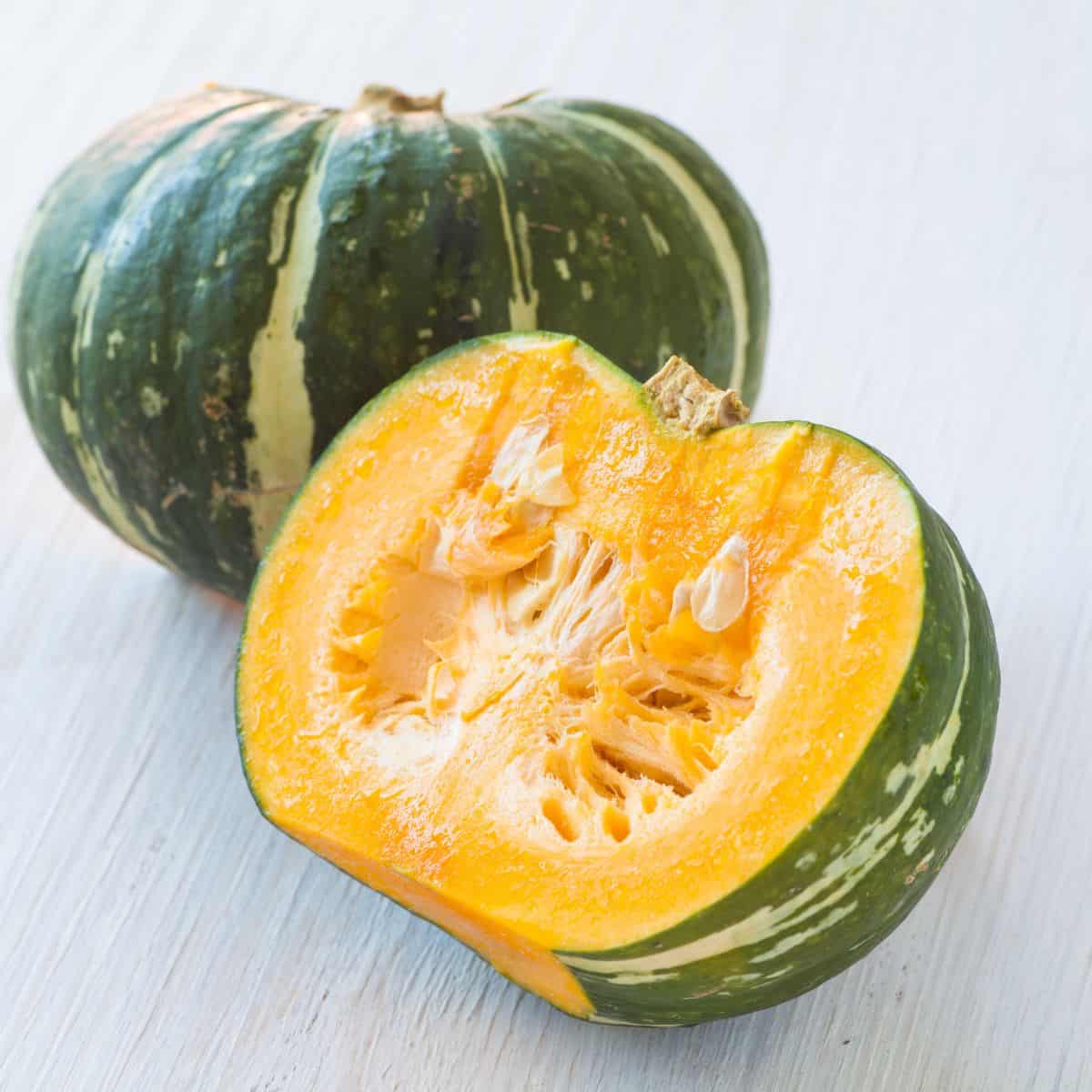
Well, let's unravel the mystery of Kabocha squash, often referred to as the Japanese pumpkin.
In fact, kabocha is the Japanese word for pumpkin squash. It is also sometimes known as chestnut squash.
Appearance: Kabocha squash is easily recognizable by its bumpy skin that is dark green in color with a vibrant dark yellow-orange flesh. It sometimes has thin white stripes. It belongs to the species Cucurbita maxima, making it a hard squash with excellent storage capabilities.
Taste and Texture: In terms of flavor, Kabocha is a standout. Its taste is often described as a very sweet squash with a slightly nutty flavor, which sets it apart from other squash varieties. In fact, some would describe it as having a chestnut-like flavor.
It also has a pleasantly smooth and creamy texture when cooked, making it a versatile ingredient in various dishes.
Culinary Uses: Kabocha squash shines in the kitchen. You can roast it to bring out its natural sweetness, mash it for creamy soups, or even use it in desserts like pies and muffins.
Its robust flavor and smooth texture make it an ideal addition to curries and stews as well.
Nutrients and Health Benefits: Kabocha squash is an excellent source of vitamin A and vitamin C, which support a healthy immune system.
It's also rich in fiber, providing digestive benefits, and contains essential minerals like potassium and iron.
Where to Find It: You can typically find Kabocha squash in well-stocked grocery stores, especially during the fall and winter months.
Additionally, check out your local farmers' markets, as they often feature fresh and locally grown Kabocha squash.
Growing Regions: Kabocha squash is grown in various regions around the world, including Japan, where it is particularly popular. In the United States, it's cultivated in states with suitable growing conditions, such as California, Florida, and parts of the Midwest.
Extended Storage: One of the remarkable features of Kabocha squash is its long storage life. When kept in a cool, dry place, away from direct sunlight, it can last for several weeks to several months.
This makes it an ideal choice for stocking up during the fall season and enjoying its delicious flavors throughout the winter.
Incorporating Kabocha squash into your diet not only introduces you to a delightful flavor but also provides a range of nutrients and health benefits.
Whether you're roasting it as a side dish or using it as the star ingredient in a hearty soup, this Japanese pumpkin has much to offer in terms of both taste and nutrition.
So, the next time you spot that bumpy-skinned gourd at the market or your local farmers' market, don't hesitate to bring home a Kabocha squash and elevate your culinary creations.
 Local Kabocha SquashShop on Amazon
Local Kabocha SquashShop on Amazon
Buttercup Squash
Buttercup squash is another winter squash variety you might not have explored yet. Its small size and round shape set it apart from larger squash varieties like Kabocha.

With its dark green skin adorned with distinctive white stripes and interestingly dry flesh, Buttercup squash is visually appealing and a flavorful addition to your culinary repertoire. It looks very similar to kabocha, in this respect.
It sounds very similar to the more well-known squash, butternut. Although different, they can be used in place of butternut in recipes due to their similar flavors and textures.
Appearance: Buttercup squash, scientifically known as Cucurbita maxima, boasts a dark green skin with distinctive white stripes. Its bright orange flesh is packed with flavor and nutrients.
Taste and Texture: Buttercup squash offers a unique taste experience. It's often described as sweet and nutty, making it a great choice for both savory and sweet dishes.
In terms of texture, Buttercup squash has a drier flesh compared to other winter squashes, giving it a unique and slightly firmer texture.
Culinary Uses: This squash's squat shape and drier texture make it a versatile ingredient in the kitchen. You can roast it to enhance its natural sweetness, use it as a base for hearty soups, or even incorporate it into pies and casseroles. Its rich flavor complements a variety of culinary creations.
Nutrients and Health Benefits: Buttercup squash is a nutritional powerhouse. It's an excellent source of vitamin A, which supports eye health, and provides essential minerals like potassium and fiber.
The combination of nutrients in Buttercup squash makes it a valuable addition to a healthy diet.
Where to Find It: Buttercup squash is commonly found in North America, where it thrives in the region's growing conditions.
You can typically discover it at local grocery stores, farmers' markets, and even in your own garden if you're an avid gardener.
Extended Storage: Like other winter squashes, Buttercup squash has good storage capabilities. When stored in a cool, dry, dark place, it can last for several weeks, allowing you to enjoy its flavors well into the winter months.
Incorporating Buttercup squash into your meals not only introduces a unique flavor but also provides a wealth of nutrients and health benefits.
Whether you're using it to create a savory soup, a sweet dessert, or a hearty side dish, Buttercup squash's distinctive taste and texture will surely elevate your culinary endeavors.
So, next time you encounter this dark green delight with white stripes at your local market, don't hesitate to bring home a Buttercup squash and explore its culinary possibilities.
 David's Garden Seeds Squash...Shop on Amazon
David's Garden Seeds Squash...Shop on Amazon
Comparing Buttercup and Kabocha
While Buttercup and Kabocha squash may appear similar since they are from the same species, you might want to delve deeper into their characteristics because their flavors, textures, and culinary uses differ slightly.
Understanding these distinctions allows you to make informed choices in the kitchen, whether you're seeking a drier and firmer texture for certain dishes (Buttercup) or a creamy, sweet option for others (Kabocha).
These comparisons help you select the right squash for your specific culinary needs and preferences, enhancing your overall cooking experience.
| Attribute | Buttercup Squash | Kabocha Squash |
|---|---|---|
| Scientific Name | C maxima | C. maxima |
| Appearance | Dark green with white stripes | Dark green with bumpy skin |
| Flesh Color | Bright orange | Dark yellow-orange |
| Flavor | Sweet and nutty | Very sweet and slightly nutty |
| Texture | Drier and firmer | Smooth and creamy when cooked |
| Culinary Uses | Versatile for both savory and | Ideal for roasting, soups, |
| sweet dishes | desserts, curries, and stews | |
| Nutrients | High in vitamin A, potassium, | Rich in vitamin A, vitamin C, |
| and fiber | fiber, potassium, and iron | |
| Where to Find | Common in North America, | Widely available in grocery |
| available in grocery stores, | stores and farmers' markets | |
| farmers' markets | ||
| Storage | Can last several weeks when | Can last several weeks to |
| stored in a cool, dry place | months in cool, dry storage |
Other Winter Squash Varieties
When considering which squash to use in your upcoming fall and winter dishes, you might also enjoy learning about the differences and distinctions of other delicious and healthy squash plants.
While Kabocha and Buttercup squash have their unique charms, the world of winter squash is vast and diverse. Let's take a tour of some other delightful winter squash varieties, each with its distinct characteristics and culinary potential:
Butternut Squash: Known for its elongated shape and sweet, nutty flavor, Butternut squash is a versatile choice. Its smooth, buttery texture makes it ideal for soups and purees.
Some say it tastes similar to sweet potatoes when mashed or pureed.

Sweet Potato Squash: This squash variety closely resembles sweet potatoes in flavor and texture. It is also known as delicata squash. It's a great choice if you're looking to add a unique twist to your dishes.

Spaghetti squash: Named for its unique stringy flesh, Spaghetti squash is a low-carb alternative to pasta. Roast it and use a fork to create "noodles" for a healthy pasta substitute.
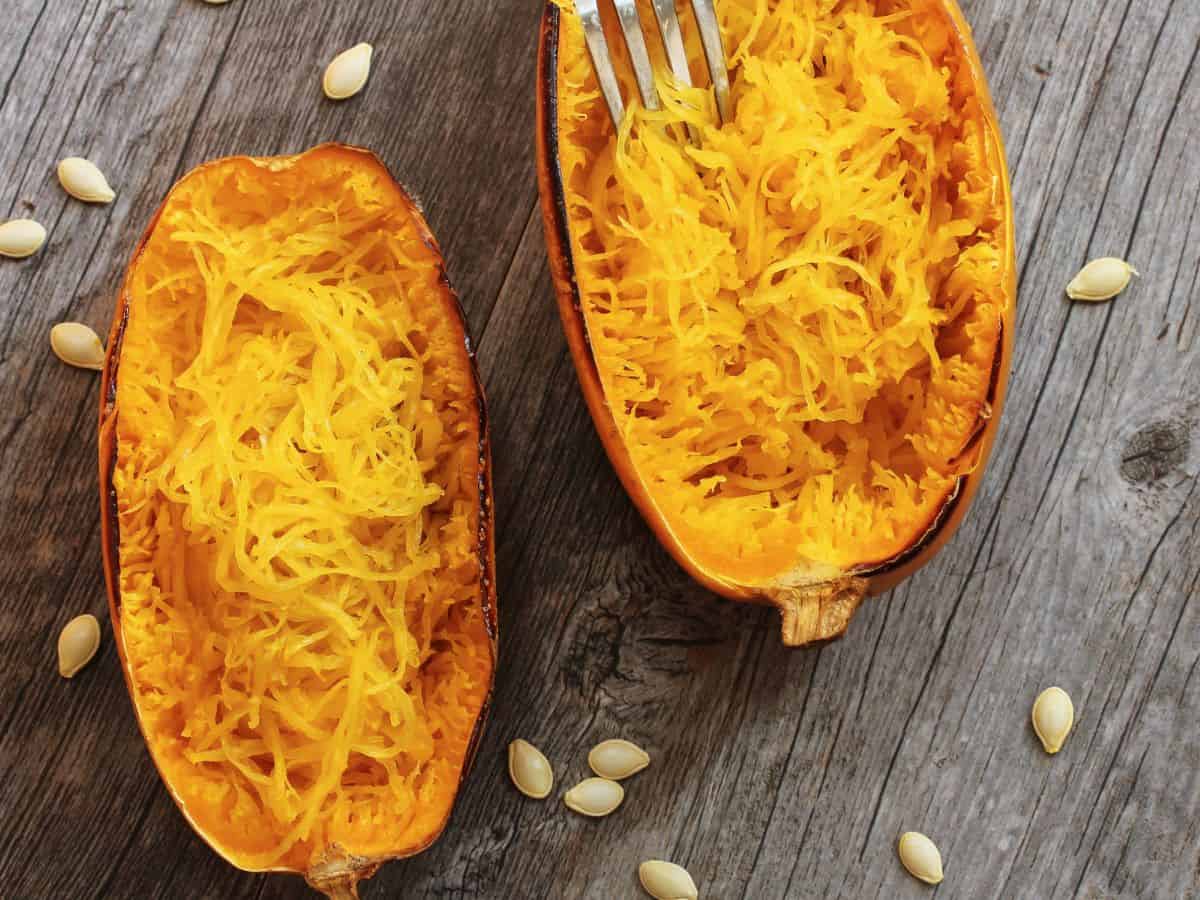
This is one of our family's favorite squash varieties to use in dishes. In fact, a quick and easy one to try is our favorite Keto Chicken Alfredo made with spaghetti squash.
Learn more about clean keto with our keto guide and meal plan.
Sugar Pumpkin: Different than large pumpkins, these are often used for making pumpkin puree.

These pie pumpkins have a smooth texture and sweet flesh, perfect for pumpkin pie or incorporating into soups and stews.
Red Kuri Squash: Also known as Japanese squash or baby red hubbard squash, red kuri has a vibrant red-orange skin and sweet flavor. It is excellent for roasting, mashing, or using in desserts like pies.
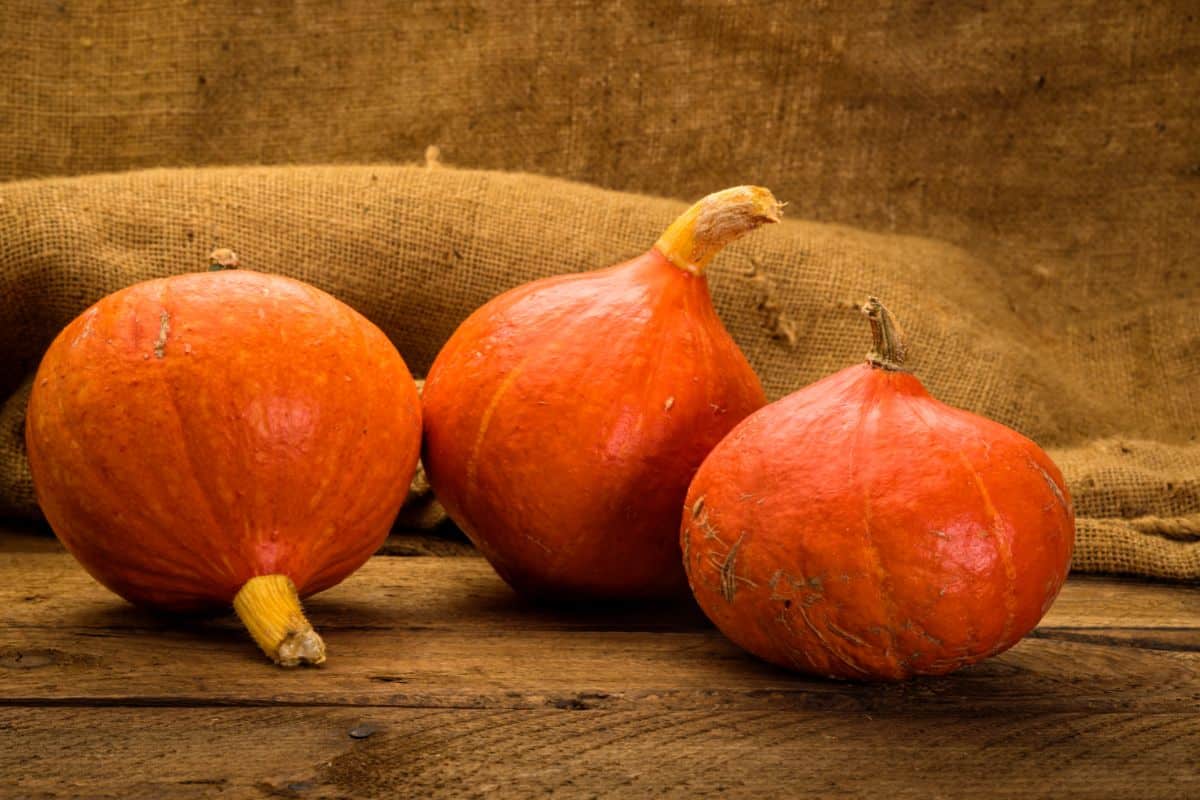
Sweet Dumpling Squash: These small, cream-colored squash have a sweet, tender flesh. They're perfect for stuffing or roasting and make for an attractive presentation.
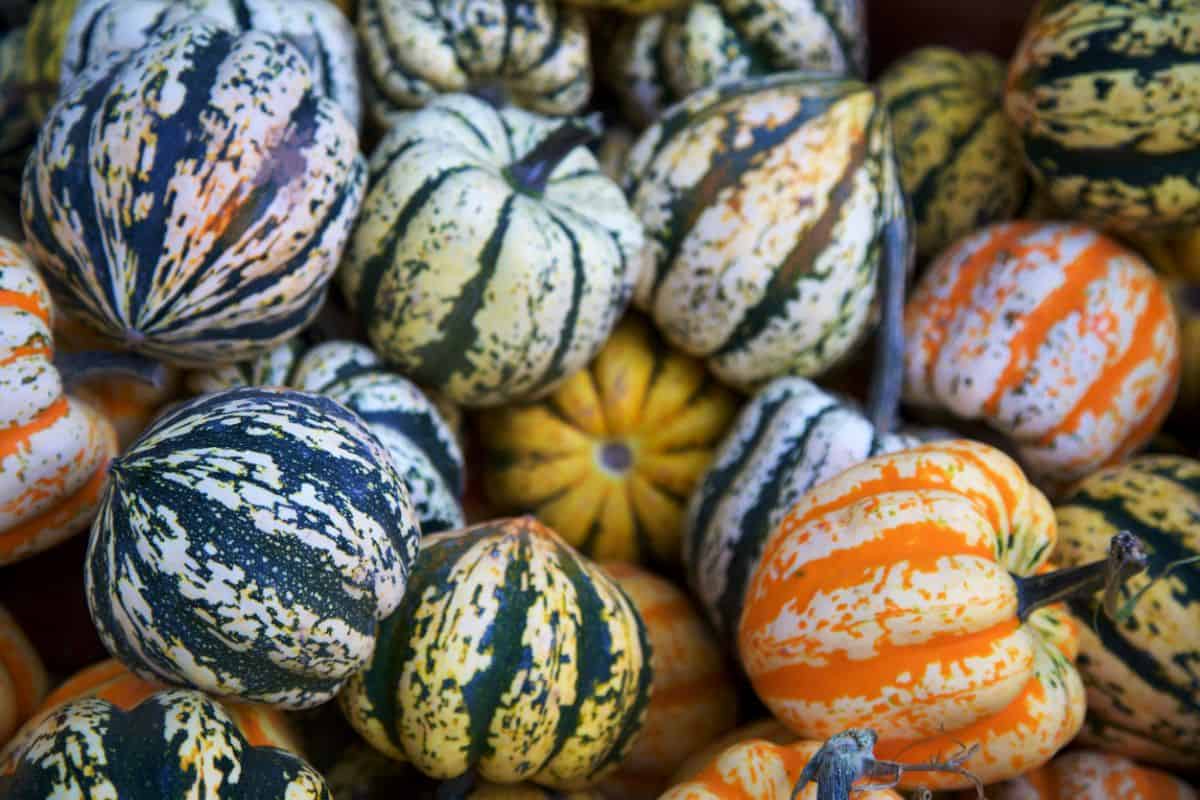
Acorn Squash: Named for its distinctive shape, Acorn squash has a sweet and slightly nutty flavor. It's often halved and roasted, with a cavity perfect for stuffing.

Cheese Pumpkins: These pumpkins are not meant for carving but for cooking. They have a creamy, buttery texture and are fantastic for making soups, pies, or roasted dishes.

Blue Hubbard Squash: With its bluish-gray skin and sweet, dense flesh, Blue Hubbard squash is perfect for baking, roasting, or mashing. It's often used in pies and soups.

Turban Squash: With its distinctive turban-like shape and colorful skin, Turban squash has a mild, slightly sweet flavor and is often used for decoration and cooking.

Carnival Squash: A cross between Acorn and Sweet Dumpling squash, Carnival squash has a sweet flavor and is perfect for roasting or using in casseroles.

Gold Nugget Squash: Small and easy to handle, Gold Nugget squash has a sweet and nutty flavor, making it ideal for roasting or pureeing.

Red Warty Thing Squash: As the name suggests, this squash has warts on its skin, adding to its visual appeal. It has a sweet, nutty flavor and is great for roasting.

Honey Nut Squash: A smaller variety with a sweet, nutty flavor and edible skin. It's perfect for roasting and stuffing.
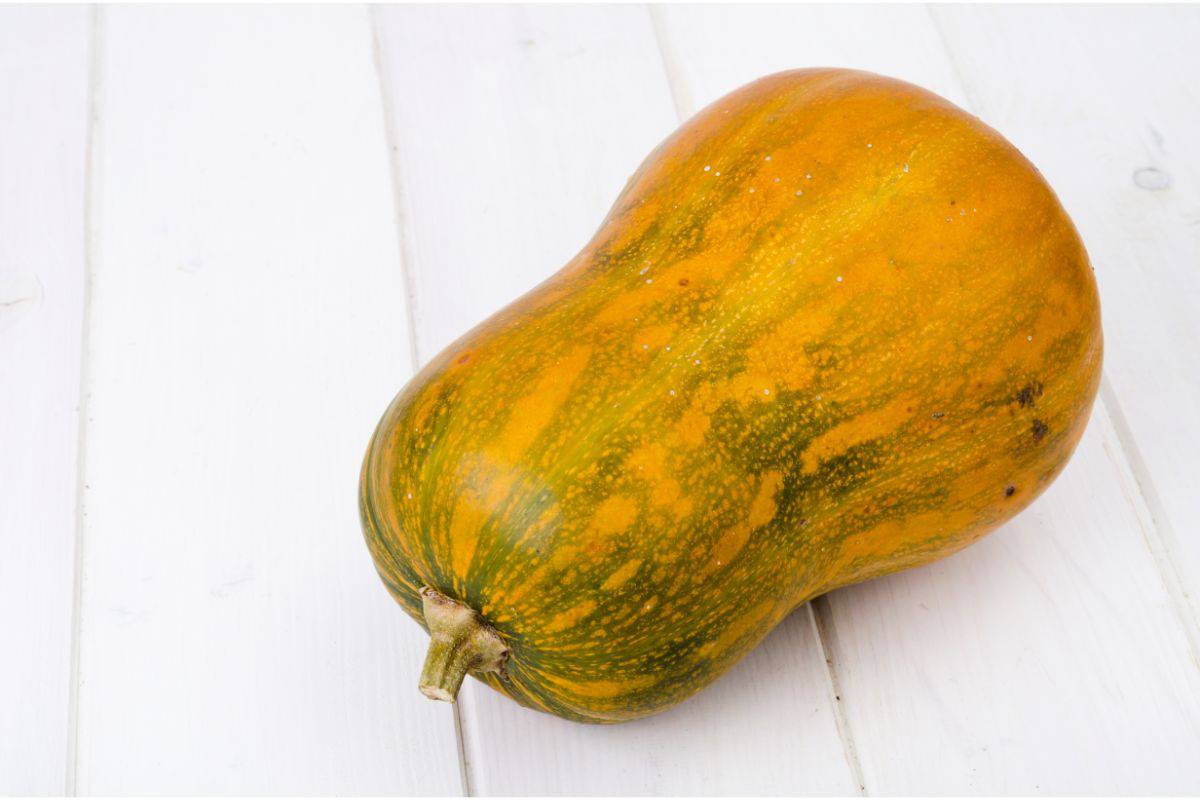
Each of these winter squash varieties offers a unique taste and texture that can elevate your culinary creations.
Experimenting with these diverse options, whether in comforting soups, savory casseroles, or delightful desserts like pumpkin pie with a hint of maple syrup and coconut milk, can add a touch of warmth and flavor to your winter meals.
So, don't be afraid to explore beyond the single type of squash you're familiar with and embrace the rich diversity of winter squashes available to you.
Comparing Nutritional Values of Winter Squash
Nutritional Value of Common Winter Squash Varieties (per 100g)
| Nutrient | Butternut Squash | Acorn Squash | Spaghetti Squash | Kabocha Squash | Buttercup Squash | Sweet Potato Squash | Sugar Pumpkin |
|---|---|---|---|---|---|---|---|
| Calories (kcal) | 45 | 40 | 31 | 41 | 34 | 86 | 26 |
| Carbohydrates (g) | 12 | 9 | 7 | 10 | 8.5 | 20.1 | 6.9 |
| Dietary Fiber (g) | 2 | 2 | 1.5 | 1.6 | 2.0 | 2.5 | 0.5 |
| Sugars (g) | 2 | 0 | 2 | 1.5 | 2.2 | 5.3 | 2.76 |
| Protein (g) | 1 | 0.9 | 0.6 | 1.2 | 1.2 | 1.6 | 1.0 |
| Fat (g) | 0.1 | 0.2 | 0.2 | 0.1 | 0.3 | 0.3 | 0.2 |
| Vitamin A (IU) | 11,434 | 878 | 31 | 7,384 | 6,132 | 18,571 | 6,000 |
| Vitamin C (mg) | 8 | 9 | 2 | 17 | 15.5 | 20 | 9.2 |
| Vitamin K (mcg) | 1.3 | 2.8 | 0.3 | 1.9 | 0.6 | 1.6 | 1.1 |
| Potassium (mg) | 352 | 347 | 140 | 544 | 320 | 448 | 340 |
| Calcium (mg) | 48 | 37 | 23 | 21 | 33 | 30 | 21 |
| Iron (mg) | 0.6 | 0.4 | 0.3 | 0.6 | 0.7 | 0.6 | 0.6 |
| Magnesium (mg) | 20 | 18 | 12 | 34 | 21 | 21 | 12 |
Nutritional Value of Less Common Winter Squash Varieties (per 100g)
| Nutrient | Red Kuri Squash | Sweet Dumpling Squash | Cheese Pumpkins | Blue Hubbard Squash | Honey Nut Squash | Red Warty Thing Squash | Gold Nugget Squash | Carnival Squash | Turban Squash |
|---|---|---|---|---|---|---|---|---|---|
| Calories (kcal) | 41 | 40 | 32 | 40 | 40 | 40 | 40 | 25 | 40 |
| Carbohydrates (g) | 10.1 | 9 | 7.2 | 9.3 | 8.3 | 9.5 | 10.3 | 6.9 | 10.3 |
| Dietary Fiber (g) | 2.3 | 1.6 | 0.5 | 0.7 | 1.6 | 2.0 | 1.8 | 0.6 | 0.6 |
| Sugars (g) | 2.5 | 2.6 | 3.4 | 2.3 | 2.6 | 2.5 | 2.9 | 3.3 | 2.9 |
| Protein (g) | 1.1 | 1.2 | 1.1 | 1.3 | 1.3 | 1.0 | 1.0 | 1.0 | 1.0 |
| Fat (g) | 0.6 | 0.5 | 0.3 | 0.4 | 0.4 | 0.3 | 0.5 | 0.3 | 0.2 |
| Vitamin A (IU) | 6,307 | 7,900 | 7,300 | 4,140 | 4,000 | 4,000 | 7,000 | 7,000 | 4,000 |
| Vitamin C (mg) | 23 | 16.9 | 8.5 | 10.6 | 6.8 | 13.0 | 16.0 | 9.0 | 18.0 |
| Vitamin K (mcg) | 4.1 | 3.8 | 0.3 | 1.9 | 1.4 | 0.0 | 4.0 | 0.0 | 0.0 |
| Potassium (mg) | 400 | 484 | 364 | 349 | 413 | 350 | 440 | 493 | 340 |
| Calcium (mg) | 34 | 37 | 33 | 27 | 38 | 24 | 42 | 33 | 30 |
| Iron (mg) | 1.6 | 1.2 | 1.0 | 1.4 | 1.3 | 0.8 | 1.0 | 1.2 | 1.4 |
| Magnesium (mg) | 34 | 30 | 34 | 37 | 29 | 23 | 39 | 30 | 33 |
(These values were generated using AI technology)
FAQ
While both of these squash varieties come from the same family, they are different types of squash. They are even very similar-looking. Both are dark green and often have light stripes with a belly button on the bottom. However, buttercup squash is smoother on the exterior, while kabocha is slightly bumpy. Kabocha is also slightly higher in calories as well as nutrient content.
Buttercup squash is quite healthy packed with antioxidants and phytonutrients like beta carotene. It also boasts plenty of fiber. It is pleasantly sweet and nutty and works well in savory meals as well as sweet desserts.
As long as you have an organically grown squash, it should be safe to eat. However, most people would not prefer to eat the skin, as it is thick and fibrous. Typically the flesh is scooped from the skin after cooking.
Kabocha translates to pumpkin in Japanese, however, they do not necessarily taste the same. Kabocha is more similar to zucchini (a summer squash) or even eggplant rather than the traditional pumpkin. It can be swapped in recipes, but the taste will likely be altered. Kabocha is actually sweeter than pumpkin!
Conclusion
As we wrap up our exploration of the diverse world of winter squash, we invite you to embrace the rich tapestry of flavors and textures these gourds offer.
Whether you find solace in the sweet and creamy Butternut, savor the slightly nutty notes of Kabocha, or delight in the vibrant colors of Red Kuri, there's a winter squash variety to suit every palate.
We want to hear from you! Share your favorite winter squash variety and your go-to squash recipe in the comments below. Let's exchange culinary inspirations and celebrate the joys of healthy, seasonal eating.
Don't forget to spread the love by sharing this article on your social media platforms, so your friends and family can join the winter squash adventure too.
And for more tips, recipes, and updates on mindful and healthy living, subscribe to our newsletter.
Thank you for joining us on this journey through the world of winter squashes.
Be well,
Natalie

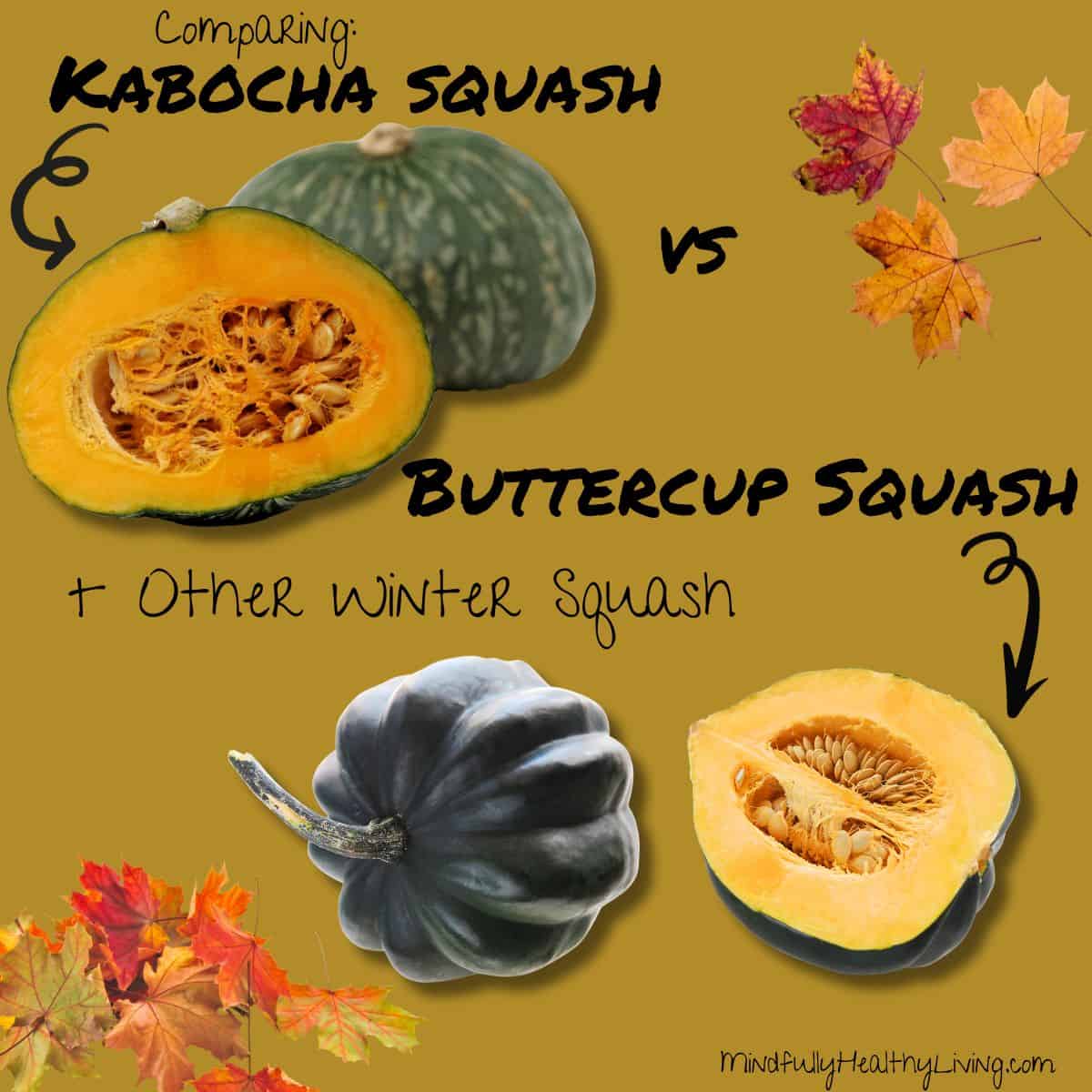
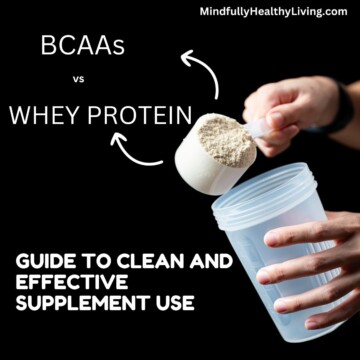
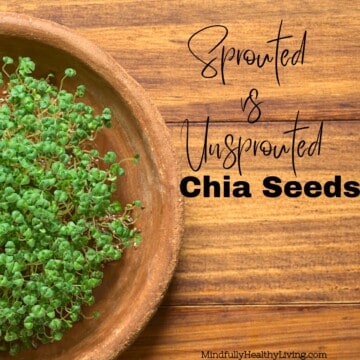
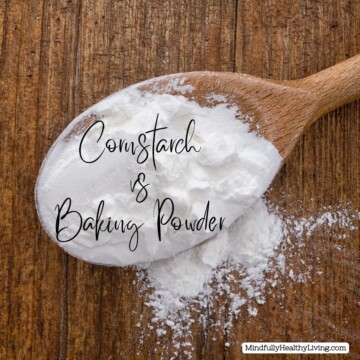
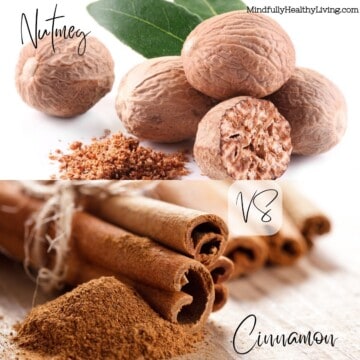
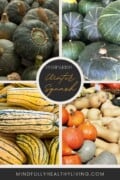
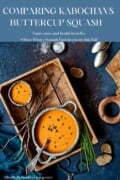

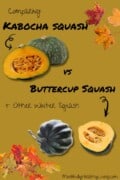
Comments
No Comments